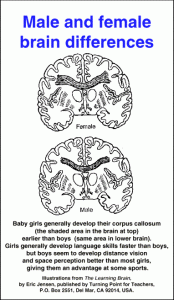At my last homeschooling conference, I had a display showcasing the traits of being either right-brained dominant or left-brained dominant (as listed on the  sidebar of this website). A lot of attendees of that conference happen to focus on “raising scholars” as their center point in their homeschools. In other words, there was high value in the left-brained scope and sequence. Interestingly, I had a higher percentage of parents, particularly females, stand in front of the board, studying the traits, and finally, with a breath of confused exasperation, declare, “I don’t think I fit in either well,” or “I fit in both.”
sidebar of this website). A lot of attendees of that conference happen to focus on “raising scholars” as their center point in their homeschools. In other words, there was high value in the left-brained scope and sequence. Interestingly, I had a higher percentage of parents, particularly females, stand in front of the board, studying the traits, and finally, with a breath of confused exasperation, declare, “I don’t think I fit in either well,” or “I fit in both.”
The logical conclusion would be, “Then they must be whole-brained.” The thing is, I don’t technically think there is such a person. I believe most people are either right-brained or left-brained dominant. Then, why do some appear whole-brained, or having more than one trait on both sides? The gender factor accounts for a lot of this.
The female gene is naturally left-brained. The male gene is naturally right-brained. Do you notice that there are a lot more boys diagnosed with things  like ADHD, dyslexia, dysgraphia, and Asperger’s than girls? Behind each of these labels is a right-brained learner. Do you notice there are more boys who learn kinesthetically than girls? This input modality is primarily used by right-brained dominant learners. Let’s take the list of right-brained/left-brained traits and determine which ones typically are associated with a gender trait.
like ADHD, dyslexia, dysgraphia, and Asperger’s than girls? Behind each of these labels is a right-brained learner. Do you notice there are more boys who learn kinesthetically than girls? This input modality is primarily used by right-brained dominant learners. Let’s take the list of right-brained/left-brained traits and determine which ones typically are associated with a gender trait.
The left-brained traits are reality, *word based (symbolic), *sequential, part, memorization, logical (mind), compliant, external perfectionism, product, and time. We know that it’s shown that females are much more verbal than boys, typically. Women tend to be better multi-taskers (organizers). Thus, in the left-brained list of traits, if you’re a right-brained dominant woman, you may also have a leg up when it comes to reading and organizing compared to your male right-brained peers because of the gender factor.
Let’s take the other side of the gender factor coin. The right-brained traits are *imagination, *picture based (3-dimensional), global, whole, association, intuitive (heart), resistant, internal perfectionism, process, and space. It’s typically accepted that women are more naturally emotional (both in how they

Read my book, The Right Side of Normal, to see how distance vision relates to later reading as another contributing factor.
feel and how they make decisions). Women, especially mothers, are often commended for their use of “mother’s intuition.” Thus, in the right-brained dominant traits, if you’re a right-brained woman, you may also have a double dose of emotional sensitivity (potentially being more prone to such things as depression and anxiety) as well as a highly developed sense of intuition compared to left-brained women.
Now let’s do the same thing for the men. In the set of right-brained dominant traits, men tend to be highly imaginative (big boy toys anyone?) as well as big picture thinkers (global). Thus, since the male gene tends to be right-brained, if you’re a right-brained dominant male, you may have a higher level of imagination and ability to think globally. In the set of left-brained traits, we tend to see males as being logic-based in their decisions as well as wanting to see a product (thus, liking to do things). Thus, if you’re a right-brained male, you may also be able to be logical (such as good at arithmetic) and seek after products.
I see the brain dominance (processing preference) information as a foundation, and then all the variables are factored in to create each unique human being. The gender factor is one of those variables. As a left-brained female, all my traits  reside on the left side of the trait chart, except I have a strong intuition from my female side. My daughter is a right-brained female, but she learned to read on her own at 5 (using the right-brained sight word preferred method) and she enjoys being organized (with certain things). My son-in-law is a left-brained male, and he has an extra strong need for logic and likes to finish things, but also has a great imagination. My hubby is a right-brained male, with a gift for global thinking and associative information (how does he know that?!). Yet, he seemed to acclimate fairly well to the left-brained world of school to be highly successful. And this is where I hook back to my opening paragraph.
reside on the left side of the trait chart, except I have a strong intuition from my female side. My daughter is a right-brained female, but she learned to read on her own at 5 (using the right-brained sight word preferred method) and she enjoys being organized (with certain things). My son-in-law is a left-brained male, and he has an extra strong need for logic and likes to finish things, but also has a great imagination. My hubby is a right-brained male, with a gift for global thinking and associative information (how does he know that?!). Yet, he seemed to acclimate fairly well to the left-brained world of school to be highly successful. And this is where I hook back to my opening paragraph.
I find it more common for right-brained women to acclimate to the left-brained school culture with the help of the gender factor. This would seem like a good thing, right? They were able to “succeed” in school despite it not being set up to best support right-brained learners. What I’ve discovered, however, is what I witnessed at this conference. Women who feel like they don’t excel anywhere. Women who hold onto the idea of “raising scholars” as all they know to do. Sure, when these women were in school, they could do a bit of this and that enough to move along the school conveyor belt. But, they never developed any of their talents and strengths housed in their dominant right side.
I remember a woman in particular who approached me after my presentation on right-brained learning at another conference, who experienced an aha moment  around this. She realized that in her early years, she was very much a right-brained, creative child. But, through the years of making it through school, she acclimated. She realized in that moment that she felt empty and without any real gift developed at all. She knew she needed to revisit all that she knew about the gifts of right-brained dominance and nurture the buried interests lying dormant within her.
around this. She realized that in her early years, she was very much a right-brained, creative child. But, through the years of making it through school, she acclimated. She realized in that moment that she felt empty and without any real gift developed at all. She knew she needed to revisit all that she knew about the gifts of right-brained dominance and nurture the buried interests lying dormant within her.
For those who are highly right-brained dominant, we need educational environments that nurture their developmental time frame for learning, that value the creative outlets, and that respect the early subject strengths that build their particular strengths and traits. When we don’t provide this, we risk losing the creative genius they offer the world. For those who are right-brained dominant that are able to acclimate to the left-brained scope and sequence, we owe them the same opportunity to develop their unique gifts and talents that would risk being dulled or extinct by the long arm of conformance. We need to protect our creative resources found in the learning lives of our right-brained children.
How does your gender factor impact your learning life?






6 responses to “The Gender Factor”